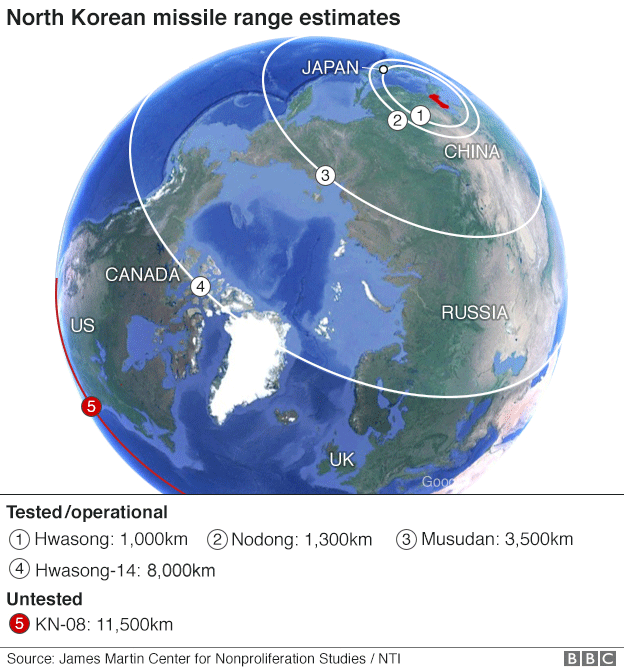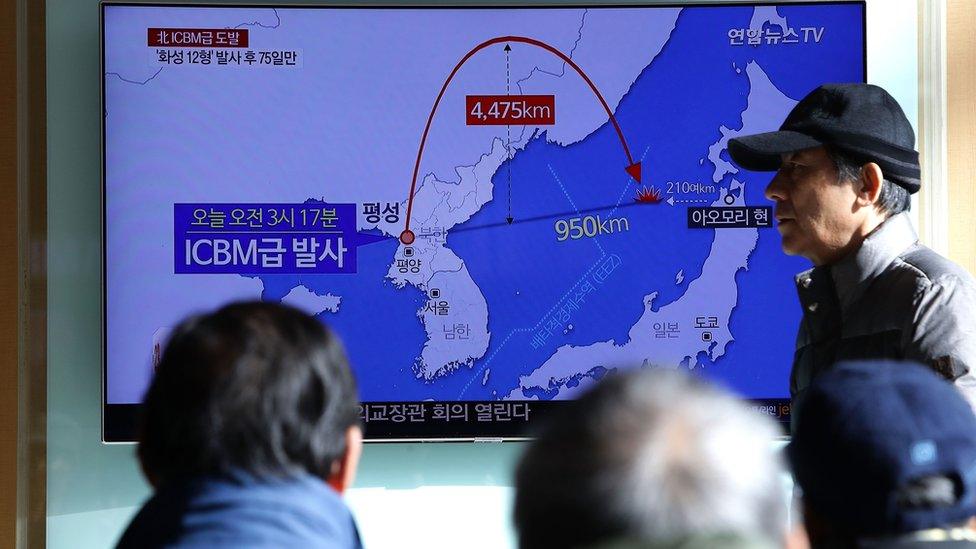North Korea: What we know about the new missile
- Published

North Korea tested its first intercontinental ballistic missile in July
After two months without a missile test, North Korea has launched its highest-ever intercontinental ballistic missile, which experts say puts the US well within range. It says this is a new missile, known as a Hwasong-15. What can we tell about this missile from the latest test?
What is North Korea saying?
The North says this intercontinental ballistic missile (ICBM) is its most powerful yet and completes the country's "rocket weaponry system development set".
It said the rocket was tipped with a "super-large heavy warhead" capable of hitting the whole of the mainland US. The rocket reached the highest altitude of any rocket tested by the North so far.
What can experts tell from its trajectory?
Last July North Korea tested the Hwasong-14 missile that demonstrated an altitude of 3,000km (1,865 miles) but there were still many voices doubting how far it would go with a warhead attached.
This test showed serious advances, although experts say more details need to emerge for more certainty.
There is speculation that the rocket was fuelled horizontally, before being placed on the launch pad, the New York Times reports., external Such a development would make the North's missiles a harder target to hit in a pre-emptive attack by the US.

North Korea says the rocket reached an altitude of 4,475km which would mean its range on a standard trajectory - as opposed to one that was fired as deliberately high - would be 13,000km. This would be "more than able to cover the continental United States, dependent on the weight of the mock warhead" likely to have been placed on it, Vipin Narang, associate professor of political science at MIT, told the BBC.

"There were the doubters on the range of Pyongyang's first two tests - and so they've improved it," he added.
"They have extended the range now out to a point that it is hard to credibly argue that North Korea couldn't have the US eastern seaboard within its range."
The only caveat would be the weight of the warhead. David Wright at the Union of Concerned Scientists points out in his blog that it is likely to have carried a very light mock warhead , externaland that "means it would be incapable of carrying a nuclear warhead to this long distance, since such a warhead would be much heavier".

But Mr Narang says the weight should not reduce range significantly - the missile should be able to handle a heavy warhead, being so heavy itself.
He adds that it shows the missile programme is improving, testing is working and, whatever the shortcomings of the earlier test, they are finding ways to fix them.
"To get this extended range in a such a short time is very impressive. They have gone from 9,500km to a 13,000km range - a technical feat."

More reading on North Korea's missiles:
What the North Korean Hwasong-15 missile launch pictures tell us

Why did the test take place at night?
The test was unusual in that it took place when the region was in darkness but there are clear advantages to Pyongyang being able to master night-time launches.
"It tests your unit's ability to fire a missile under cover of darkness and there is a concealment and readiness component to this," Mr Narang points out. "If you are worried about the US trying to target missiles, it gives you a slight advantage. It is just that bit easier to hide and move things at night."

So a missile would be that little bit less vulnerable to US attack. Then there is the fact that missiles are harder to intercept at night.
"At night there are certain phases of a warhead's flight that doesn't have the illumination of the Sun, so it's harder to pick up," he adds. It is certainly not impossible to intercept but a launch under cover of darkness marginally improves a missile's ability to evade missile defences.
What is the message?
It has long been North Korea's stated ambition to complete its nuclear arsenal of weapons and be able to have the continental United States within range.
This launch is the North saying to the world that it believes it has achieved both those goals, Mr Narang says.
There are some who doubt whether North Korea can miniaturise a warhead. And the country has yet to prove it has the re-entry technology needed to bring a warhead back through the Earth's atmosphere.

But Mr Narang warns that with every doubt comes the determination to prove it wrong.
"It worries me that we are daring Kim Jong-un to conduct what is known as the juche bird test," which is an atmospheric nuclear test - a highly risky test.
"Those that still think a preventive war is an option, have to make the argument that North Korea doesn't have the ability to hit US with a warhead."
- Published29 November 2017

- Published9 August 2017

- Published10 August 2017